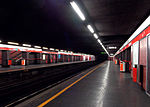Casa di Riposo per Musicisti
1896 establishments in ItalyGiuseppe VerdiGothic Revival architecture in ItalyPalaces in MilanTourist attractions in Milan

The Casa di Riposo per Musicisti (literally 'rest home for musicians') is a home for retired opera singers and musicians in Milan, northern Italy, founded by the Italian composer Giuseppe Verdi (whose statue is outside the building) in 1896. The building was designed in the neo-Gothic style by Italian architect, Camillo Boito. Both Verdi and his wife, Giuseppina Strepponi are buried there. A documentary film about life in the Casa di Riposo, Il Bacio di Tosca (Tosca's Kiss in the US), was made in 1984 by the Swiss director Daniel Schmid.
Excerpt from the Wikipedia article Casa di Riposo per Musicisti (License: CC BY-SA 3.0, Authors, Images).Casa di Riposo per Musicisti
Via Raffaello Sanzio, Milan Municipio 7
Geographical coordinates (GPS) Address Nearby Places Show on map
Geographical coordinates (GPS)
| Latitude | Longitude |
|---|---|
| N 45.4704 ° | E 9.1548 ° |
Address
Casa Verdi
Via Raffaello Sanzio
20145 Milan, Municipio 7
Lombardy, Italy
Open on Google Maps








